Gentle and bright flowers among the emerald foliage will certainly decorate your garden and make it elegant and luxurious. This colors can be attributed to Camellia, which is very similar to a rose, but has more tender outlines of petals and grows in the form of a small bush.
Such a plant, exotic and excellent, will attract attention and make you admire for a long time. Of course, growing this beauty in our latitudes is not so easy, but Camellia costs all your efforts when landing and care.
In this article, we will consider the features of the camellia in more detail, we will tell about the most basic types and varieties of this plant. And also note all the important nuances of the agricultural machinery growing camellia in the open soil and at home.
Features and description of Camellia
Camellia is a decorative evergreen shrub or a small tree that can decorate any plot with its glossy leaves and incredibly beautiful colors. Garden Camellia refers to the tea family and to the family of camellia, which makes this flower close to all the well-known tea. The natural habitat of Camellia is the tropical or subtropical territories of Japan, Korea, Malaysia, Java, Philippines.
The first mention of Camellia refers to 1725 g BC. It was at this time that one of the Chinese emperors loved to drink infusion from the leaves of Camellia. He even admitted this drink to his beloved. Nowadays, this drink is called tea, which loves millions of people around the world. In Europe, this wonderful flower appeared in the 18th century, where the Jesuit monk Joseph Kamellus brought him, in honor of which Botany Karl Linny and called this exotic plant.
Camellia Description:
- Camellia is a tropical plant and in our territory it is possible to grow it in winter gardens. However, in recent years, more and more frost-resistant varieties of this flower are excreted, which can be grown in open ground.
- The main unusual feature of Camellia is its bloom during resting period - from the fall in spring. It is for this period that flower can be taken into room with a cool temperature.
- Camellia cultivation is possible and home conditions, but here you can face problems. After all, Camellia requires rather low temperatures for the formation of buds - the temperature of 12 degrees of heat is optimal.
- Currently, there are a large number of garden camellia hybrids, which have excellent winter hardiness and flowering duration.
- Camellia is growing in the form of a busta or small tree. Height can reach 2 meters.
- The entire Camellia bush is thickly covered with glossy, leathery leaves, which can grow to 3-17 cm long.
- The form of the leaves can also be different - oblong, egg-shaped, elliptic.
- Flowers camellia are quite large, in diameter can reach 5-12 cm.
- Flowers are stunned and consist of five petals with a wedge. Grow single.
- There are six forms of Camellia colors, from simple to very terry.
- Color shades can also be different: White Camellia, Pink Camellia, Red, Lilac Camellia.
- Camellia bloom begins in the fall and lasts about 2-3 months. Optimal flowering falls in February, when Camellia flowers bloom to maximum. Then the whole bush is thickly covered with bright colors.
- Appreciates the decorativeness of leaves and flowers. It is used to create bright interiors of apartments and for placing parks. Flowering camellia are ideal for winter gardens and veranda.
- To date, there are more than 10,000 variety of Camellia varieties.
Variety of species and varieties of camellia
Thanks to the vast work of breeders, a large number of Camellia varieties are derived, which are distinguished by different levels of frost resistance, flowering duration, as well as sizes and colorful colors. Let's look at the main types of this flower and their varieties.
Gorna Camellia
- There are several synonyms for this type of Camellia: mountain tea mountain, Camellia Miyagi, Sazanka.
- The natural area of \u200b\u200bthe habitat of Camellia Mountain is considered the territory of Japan, namely Okinawa Island, Kyushu. This flower prefers to grow in mountain forests.
- The Japanese often call this flower - "Flower of the Winter Sun".
- The flowering of this type of camellia lasts from November to February.
- The shrub of the plant in height can reach 3-4 m.
- The leaves are small, oblong, long to 7 cm. The surface is glossy, dark green.
- Flowers grow single or collected 2-3 pieces in inflorescences.
- In the culture you can meet the garden varieties of Camellia, great for growing in cool rooms.
Popular varieties:
- Camellia "CHANSONETTE". Mountain camellia with beautiful pink flowers.
- Camellia "Daydream". This plant pleases with simple white flowers with a pinking border along the edge of the petals.
Chinese Camellia
- Chinese Camellia has another name - Camellia Booh.
- It is this kind of Camellia that is used to produce black and green tea.
- Used in production scale.
- In nature grows in Japan and China. Prefers the slopes of mountains, various gorges and undergrings.
- Shrubs of this species are quite high, can reach 15 m in nature.
- Glossy leaves, oblong, up to 10 cm long.
- Flowers grow singly or a few pieces on short flowers.
- The colors prevailing a white shade.
- Mostly grown in a subtropical wet climate. Chinese camellia in the garden has a slight distribution.
Camellia Japanese
- One of the most popular and used Camellia species. It is used to remove new varieties of garden and indoor camellia.
- The natural habitat of Camellia Japanese is considered the territory of Japan, China and Korea.
- In Japan, this plant is very popular and revered as well as the famous Sakura.
- This view of Camellia can grow in the form of shrubs and small trees. In height, this plant can reach 15 m.
- Ophid leaves up to 10 cm long with a glossy surface of a dark green color.
- Flowers are small up to 4 cm in diameter, but in the culture you can meet garden hybrids with flowers up to 12 cm in diameter.
- Flowers grow singly or several pieces in small inflorescences.
- In the form of flowers can be different: simple, semi-marched, terry.
- The shades of flowers of Japanese camellia are also happy: white, pink, red, motley.
- It is widely used for growing in personnel, containers and in open soil.
Popular Sorts of Japanese Camellia:
- Camellia "Adolf Adyusson". Flowers the plant of this variety with bright semi-world colors.
- Camellia "Alba Simplex". It is distinguished by a simple structure of colors. The shade of them during flowering white.
- Camellia "Betty Sheffield". Beautiful white-colored terry flowers with lots of pink strokes.
- Camellia "Tammy". The flower of this Camellia variety looks like a white star with an unusual pink border around the edge of petals.
Hybrid Camellia Williams
- This kind of camellia consists of a large number of hybrid varieties that are well adapted to European frost and cold.
- Most often has the shape of small trees up to 5 m in height.
- Feature of flowers of hybrid camellia .- After a bunch of plants, the plants are resetting faded flowers.
In addition to the types of Camellia, Camellia is golden, Camellia Mesh, Camellia Salyuenskaya.
Camellia breeding methods
Camellia is quite simple can be diluted on their own. For their reproduction, several ways are suitable: seed reproduction, pavement, reproduction with the help of gifts and by grafting. Let's consider in more detail the features of each method.
Seed reproduction of Camellia
- Camellia seeds are very poorly stored and quickly lose their germination, so you need to search immediately after collecting fresh seeds.
- When using such a method, it is necessary to remember that the future plant is lost all its varietal signs.
- Before sowing seeds, it is necessary to prepare special containers with a nutrient soil mixture.
- For the active growth of seedlings, the soil mixture should consist of peat and sand in equal proportions.
- After sowing, the seed box must be stored at a temperature of 20-22 degrees of heat.
- Camellia is distinguished by a long period of seedlings. This process can take from you from a few weeks to a year.
- Next, when 2 strong leaves appear on Camellia seedlings, you need to dive into separate pots.
- This method is preferred, since the plant grown from seeds is better to take root and adapt to natural climatic conditions.
- Young plants grown from seeds only in 5-8 years, although there are varieties that can be seen in 2-3 years.
Reproduction of cuttings
- This method of breeding is used to remove the hybrid Camellia varieties.
- Preparation of semi-respess cuttings is best in the middle of summer.
- To do this, you need to use not young shoots, but half-hearted. Usually they are olive.
- The length of one cutter should be about 7 cm. At the same time, make sure that there are 2-3 nodes, as well as the stuffing and top kidneys, 3-5 strong leaves.
- The bottom of the cuttings need to trim under the oblique angle and break the leaves.
- Then the entire landing material for a while place in the solution of the rooting agent. For example, the corneumine is suitable.
- Next prepare containers for rooting cuttings and soil mixture. Typically use a mixture of sand, peat ground and leaf land.
- Looking out the harvested cuttings in the boxes and put in a greenhouse with a temperature not lower than 22 degrees of heat. It is also important to provide lower container heating.
- Usually rooting occurs within 2-3 months, and this is long enough.
- The flowering of Camellia grown from cuttings can occur in a couple of years.
Reproduction by chains
- This method is less laborious and expensive.
- For the cultivation of camellia, with the help of the grooves, it is necessary to choose the bottom escape on a healthy and strong shrub and bend it to the ground.
- At a certain point, the Escape is covered with soil mixture.
- With this method of reproduction, you will get an adult and flowering plant in a year.
Reproduction by vaccinations
- Another way to breed camellia on their own. Most often used by grafting with cuttings.
- Conduct vaccination three weeks before the beginning of the growing season.
- At the very Earth you need to make a split and put a stalk there.
- next, the place of vaccination must be sprinkled with the soil and cover the entire plant with a glass cap.
- With this method, the plant will bloom faster.
Stages of preparation for landing camellia
Camellia cultivation is a very complex and time-consuming process, especially in the conditions of our climate. Therefore, to get a beautiful, and most importantly blooming, plants, be sure to carefully prepare. It is important to choose the right Camellia varieties and healthy seedlings. The main thing in the right cultivation of Camellia is the landing site and soil preparation.
Stage 1. Selection of Camellia seedlings
The main rule of successful cultivation of an exotic plant is a properly chosen variety to your climatic conditions. To date, a large number of frost-resistant varieties are derived, which feel great in our cold. For winter, such plants without problems can be transferred to cool premises with a temperature not higher than 15 degrees.
It is best to select hybrid varieties that are best adapted to climate conditions. Also buy camellia is necessary in a blooming condition. Since it is an evergreen plant, then it is gaining strength during flowering.
Purchase Camellia seedlings only in specialized nurseries or agrofirmas, which are professionally engaged in the cultivation and breeding of exotic plants. Before buying, carefully inspect the plant, it should not be damaged and signs of disease.
Stage 2. Selection of Places for Landing
Many beginner gardeners have a question where Camellia grows. This is a very important point in the cultivation of this bright flower. Camellia is a plant of subtropics and tropics, so it needs to choose the appropriate place. For laying buds and kidney, a light day should consist of at least 13 hours. It is important to find a place in a light fellow, which for a long time during the day will be lit by the sunshine. It should also be remembered that the selected area should be closed from winds and drafts.
Perfectly camelia feel next to the garden trees with various buildings that provide the right shadow plant. Camellia can be grown in oak personnel, which are taken out in the summer, and in the winter are placed in cool premises.
Stage 3. Soil preparation for landing
It is important to pick up for landing camellia nutritious, loose and weakness soil. It is in such conditions that you will get a strong and healthy plant. Before boarding, it is necessary to thoroughly move the soil, adding compost into it. The soil must also be sufficiently humid and pass the air and moisture well. The soil at the selected area should consist of humus, coniferous earth, peat and sand. Also for planting camellias you can use the soil mixture for rhododendrons, which is sold in specialized stores.
The technology of landing camellia in the open soil
- It is best to plant camellia into open ground during rest, since in spring time these plants have the most active growth. And they just do not endure any transplant. You can plant camellia to open ground in November.
- For landing on the selected area you need to prepare landing pits.
- The size of the holes should be more earthen coma on the root system of Camellia. Experienced gardeners are recommended to do the pit much deeper, so that the plant makes it faster.
- Since Camellia prefers a special soil mixture, then in case of poor-quality land in the landing well, the bottom can be seen with a special film for a pond in a small hole.
- At the bottom of each pit, it is necessary to put a layer of drainage to prevent long-standing water in the roots of the plant. As a drainage you can use fine gravel or clayzit.
- It is further important to prepare the soil, which should consist of humus, sand, peat and coniferous land. This soil mixture can add a little crushed fir or pine crust.
- If you planted camellia in the pots, then be sure to pick a fairly wide pot so that the root system of the plant is enough space. At the bottom of the pot also need to put a layer of drainage.
- Next, span the saplings of Camellia with water and carefully remove it from the container. It is important to do it very carefully, since the root system of the plant is fragile and may be damaged.
- Place the seedlings in the prepared wells and neatly sprinkle the soil, slightly tamping his hands.
- When landing, you need to remember that it is impossible to plunge the root cervia, it should be on the same level with the surface of the Earth.
- The soil around the plant can be closed by peat or fallen foliage.
Camellia Growing Agrotechnics: Secrets and Neuances Care for Exotic Flower
It is important not only to put Camellia correctly, but also to ensure further regular and attentive care. Only then your exotic beauties will delight you with lush and incredibly beautiful blossoms. Camellia's care consists in regular watering, feeding and pest control.
Watering Camelli
Camellia loves growing on wet soil, but without excessive moisture. In a spring and summer time, the plant must be poured only with soft water abundantly and regularly. You can also use slightly warm water. Camellia speaks well on spraying, although it is not necessary. Spray also need to be soft water. Also remember that the plant can be sprayed before the appearance of colors. In winter, every watering is stopped.
Temperature and lighting
For active growth and flowering camellia, a large amount of light is important, however, the plant should not be under the open sunshine. If you grow Camellia at home, find her place on the western or east side.
The temperature is also very important for normal growth of camellia. Laying kidney and buds occurs at a temperature of 18-20 degrees. And for normal flowering, the temperature should be 8-10 degrees.
Loosening and mulching
Periodically, the soil around the camellia should be loosened, since this plant prefers land, easily transmitting air and moisture. Swimming is most often carried out after irrigation. You can also add mulch in the process of a weeding, which will protect the plant from excessive moisture evaporation. As a mulch, you can use a dry peat or bark of trees. When mulching, make sure that the root neck remains open.
Camelli feeding
Camellia reacts perfectly to making fertilizers. For this plant, fertilizers are suitable, which usually make plants loving acidic soils. The best time for feeding Camellia is early spring when the plant is completely woken up. At this time, integrated mineral fertilizers can be used, which includes nitrogen, phosphorus, potassium, sulfur. Avoid making feeding in winter and autumn during peace.
Camellia trimming
With proper care, Camellia does not need trimming. This plant is distinguished by a thick and beautiful crown, which has the right form. However, it is possible to periodically carry sanitary trimming, in the process of which damaged shoots should be removed. At the same time, after flowering, you can spend both forming trimming, removing the top of the kidney branches.
Camellium Change
Camellia need only from resting period, namely from November to February. It is in this case that your plant will take root and grow a strong shrub. Young plants transplant once every 2 years, and adults can grow in one place long enough - up to 8 years. After that, it is better to transplant to another area.
Fighting diseases and pests
Diseases:
- Root rot. This disease most often amazes camellia. It may appear due to incorrectly plant care, irregular or excessive irrigation, incorrectly selected location. At the plants begins to rot the root system, because of what buds and leaves are faded and fall. In this case, the plant needs to dig and burn.
Pests:
- Aphid. To combat this pest, you can use a soap solution.
- Cute tick. It can easily cope with it using an emulsion based on various oils.
Camellia Winter
Camellia can withstand frosts in the outdoor ground up to minus 20 degrees. If you grow this flower in a softer climate, then no special care for Camellia is needed. It is possible to slightly cover it from bright sunlight and climb the soil around it with fallen foliage. If the climatic conditions of your area are more severe, then it is best to plant camellues in tubs and pots, and with the onset of winter to carry out beauties into a cool room with a temperature not higher than 15 degrees.
Using Camellia in Landscape Design
Camellia is a very bright and unusual flower, which will certainly decorate your plot.
- Curly Camellia varieties are often used to decorate arbors and fences.
- Beautifully these plants look in single landings.
- Designers use camellia to create original garden compositions.
- Camellia are a valuable decoration of winter gardens.
- These bright flowers can be grown in the frames, which in the summer originally look at the site.
Stock Foto Camellia in landscape design
You can more clearly see all the examples and the features of the use of this unusual plant in the design of the site on the photos proposed below.
Single landing of camelli
Use Camellies to accuse arbor and walls at home
Use Camellia to create garden compositions
Camellia is a very beautiful and unusual plant capable of turning your plot into a bright Japanese garden. And you should not be afraid of difficulties and hassle associated with the cultivation of this beauty. As a result, you will get a real work of art.

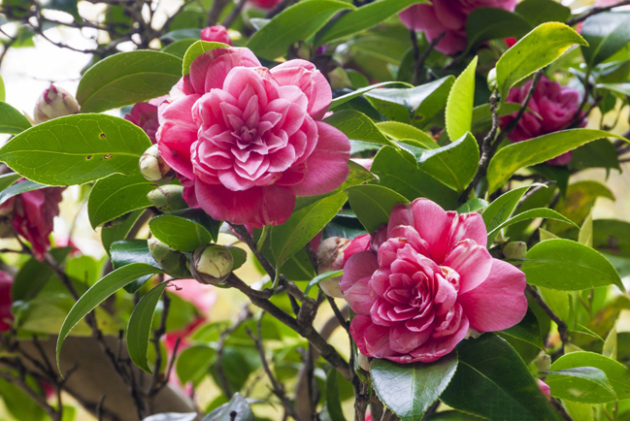
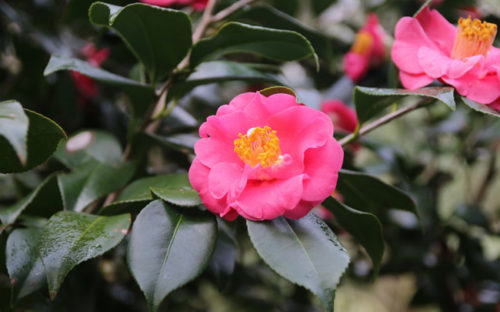
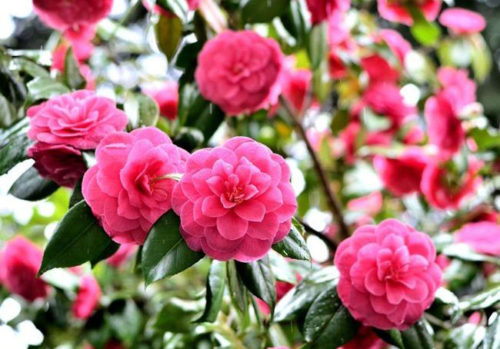
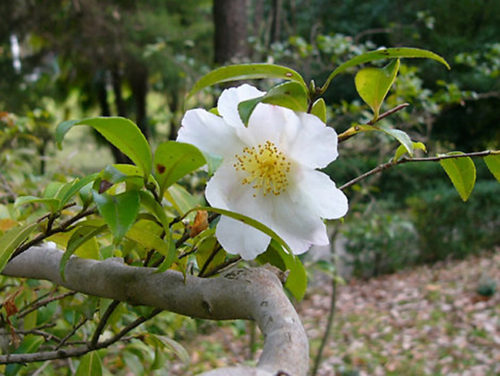
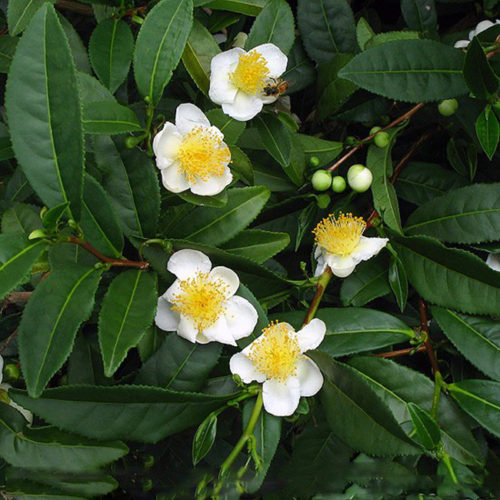
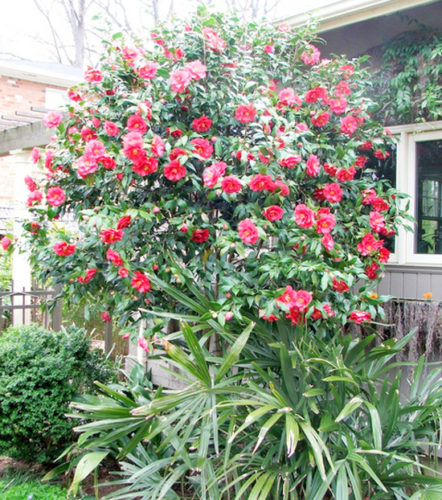
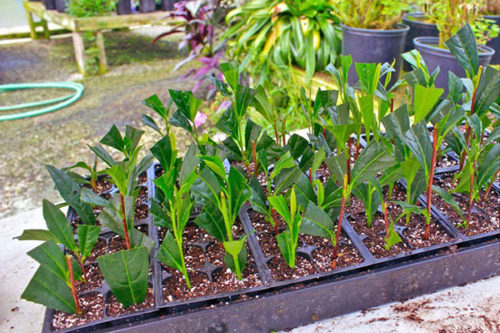
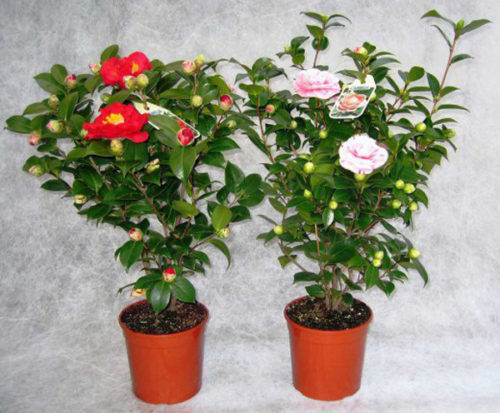
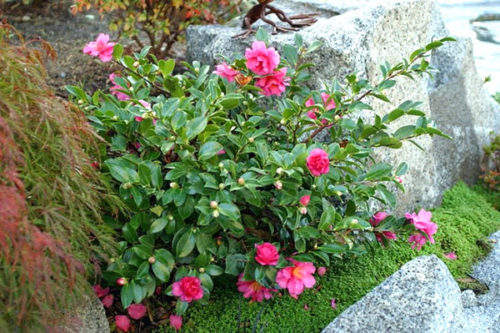
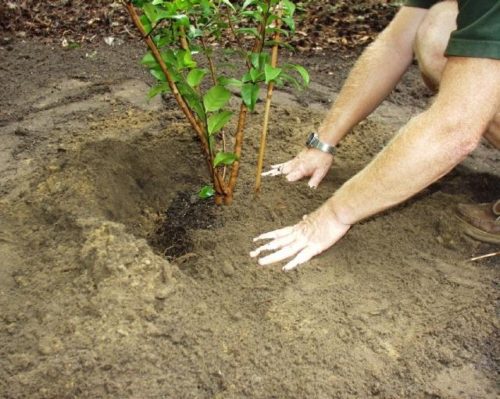

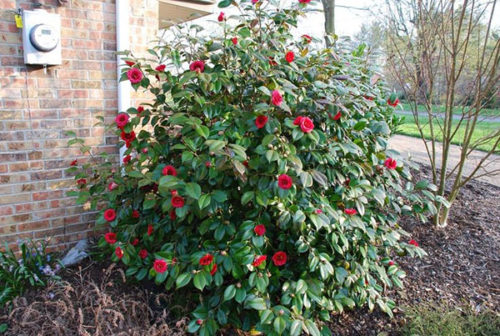
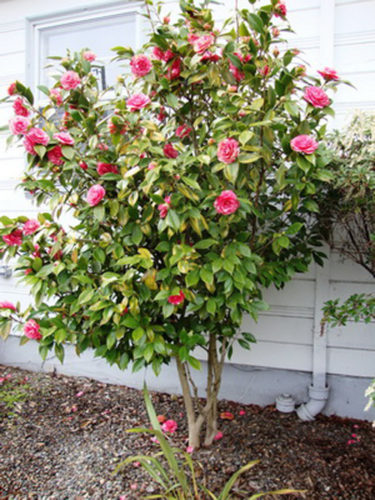
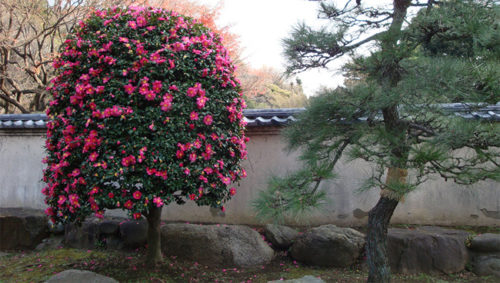
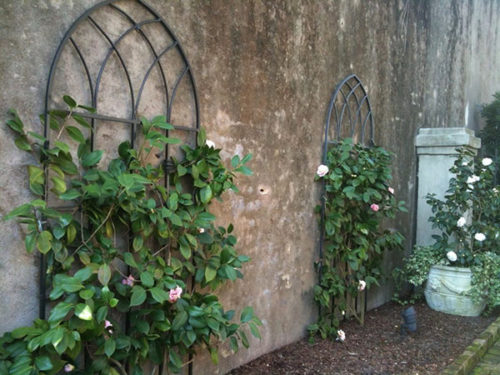
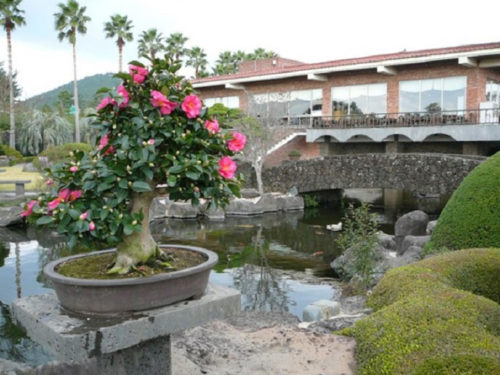












 Start a discussion ...
Start a discussion ...